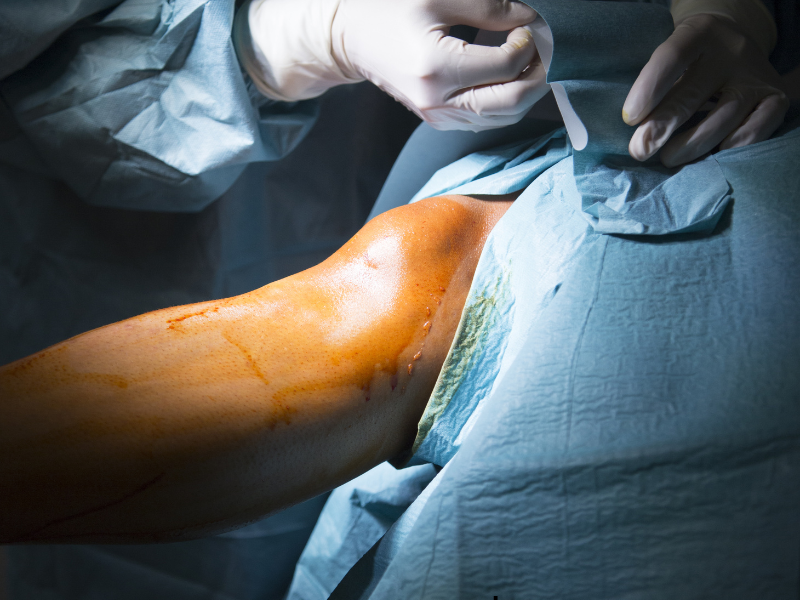Knee Arthroscopy

Find The Best Knee Arthroscopy Surgeon
Dr. Howarth, an experienced orthopedic surgeon, offers knee arthroscopy services designed to diagnose and treat various knee conditions with minimally invasive techniques. This procedure is ideal for addressing issues such as torn cartilage, damaged ligaments, or inflamed joint linings. Through small incisions, Dr. Howarth uses an arthroscope to provide a clear view of the knee’s interior, allowing precise and effective treatment with minimal recovery time. Patients benefit from reduced pain, quicker healing, and improved mobility, ensuring a swift return to their daily activities.
About Knee Arthroscopy
Knee arthroscopy is a minimally invasive surgical procedure used to diagnose and treat various conditions within the knee joint. It involves inserting a small camera, called an arthroscope, and specialized surgical instruments into the knee through tiny incisions. The arthroscope allows the surgeon to view the inside of the knee on a monitor, providing a clear and detailed visualization of the joint. This method is preferred because it causes less tissue damage compared to traditional open surgery, resulting in quicker recovery times and reduced post-operative pain.
When Is Knee Arthroscopy Recommended?
Knee arthroscopy is commonly performed for several knee conditions, including:
- Torn meniscus: To remove or repair damaged cartilage.
- ACL reconstruction: To repair or replace the torn anterior cruciate ligament.
- Cartilage damage: To smooth or remove loose pieces that may be causing pain or mobility issues.
- Synovitis: To remove inflamed tissue causing knee pain and swelling.
- Patellar disorders: To correct issues related to kneecap movement or alignment.
Procedure Details
During the procedure, the patient is usually under local, regional, or general anesthesia, depending on the severity of the issue and patient preference. The surgeon makes two to three small incisions around the knee area. Through one incision, the arthroscope is inserted to capture live images, while the other incisions allow surgical tools to be introduced to repair, remove, or trim damaged tissue as needed.
Advantages of Knee Arthroscopy
- Minimally Invasive: Only small incisions are made, reducing the risk of infection and scarring.
- Quick Recovery: Patients typically experience faster recovery times compared to open surgery, with many returning to regular activities within a few weeks.
- Accurate Diagnosis and Treatment: The use of an arthroscope provides a clear view of the knee’s internal structures, allowing precise diagnosis and targeted treatment.
Recovery and Post-Operative Care
After knee arthroscopy, most patients are able to go home the same day. Recovery time varies based on the extent of the surgery but generally involves:
- Rest and elevation of the knee to reduce swelling.
- Physical therapy to restore strength, flexibility, and full range of motion.
- Pain management using prescribed medication or over-the-counter options.
- Follow-up appointments to monitor healing progress and address any concerns.
Knee arthroscopy is an effective solution for many knee-related conditions, offering a quick and efficient approach to diagnosing and treating joint issues with minimal disruption to a patient’s daily life.
Knee Arthroscopy FAQ's
Knee arthroscopy is a minimally invasive surgical procedure used to diagnose and treat problems within the knee joint. A small camera (arthroscope) and surgical instruments are inserted through small incisions to visualize and repair the knee.
Knee arthroscopy can address a range of conditions, including:
- Torn meniscus
- Ligament tears (e.g., ACL, PCL)
- Cartilage damage
- Loose bone or cartilage fragments
- Inflammation or swelling of the joint lining (synovitis)
The procedure typically lasts between 30 minutes to an hour, depending on the complexity of the condition being treated.
Patients may experience some discomfort after the procedure, but pain is usually manageable with prescribed pain medication. The minimally invasive nature of the surgery generally results in less pain compared to open surgery.
Recovery time varies based on the procedure performed and the individual’s overall health. Most patients can return to normal activities within 4 to 6 weeks, but full recovery may take up to 3 months for more complex repairs.
Yes, physical therapy is often recommended to help restore strength, mobility, and function in the knee joint. Your orthopedic surgeon will provide a tailored rehabilitation plan.
As with any surgical procedure, there are potential risks, including infection, bleeding, blood clots, or damage to surrounding tissues. However, these risks are minimized with proper care and technique.
Most patients can walk shortly after the procedure, but crutches may be necessary for a few days to weeks, depending on the type of surgery performed. Your surgeon will provide specific guidance on weight-bearing activities.
Post-surgery care includes:
- Keeping the knee elevated
- Applying ice to reduce swelling
- Using prescribed medications
- Following physical therapy exercises
- Avoiding strenuous activities until cleared by your doctor
Knee arthroscopy has a high success rate for diagnosing and treating various knee issues. Outcomes depend on the specific condition being treated, but many patients experience significant pain relief and improved knee function post-surgery.
Ready to Get a Orthopedic Consultation?
Simply give us a call and book an appointment for yourself. We are here to help.